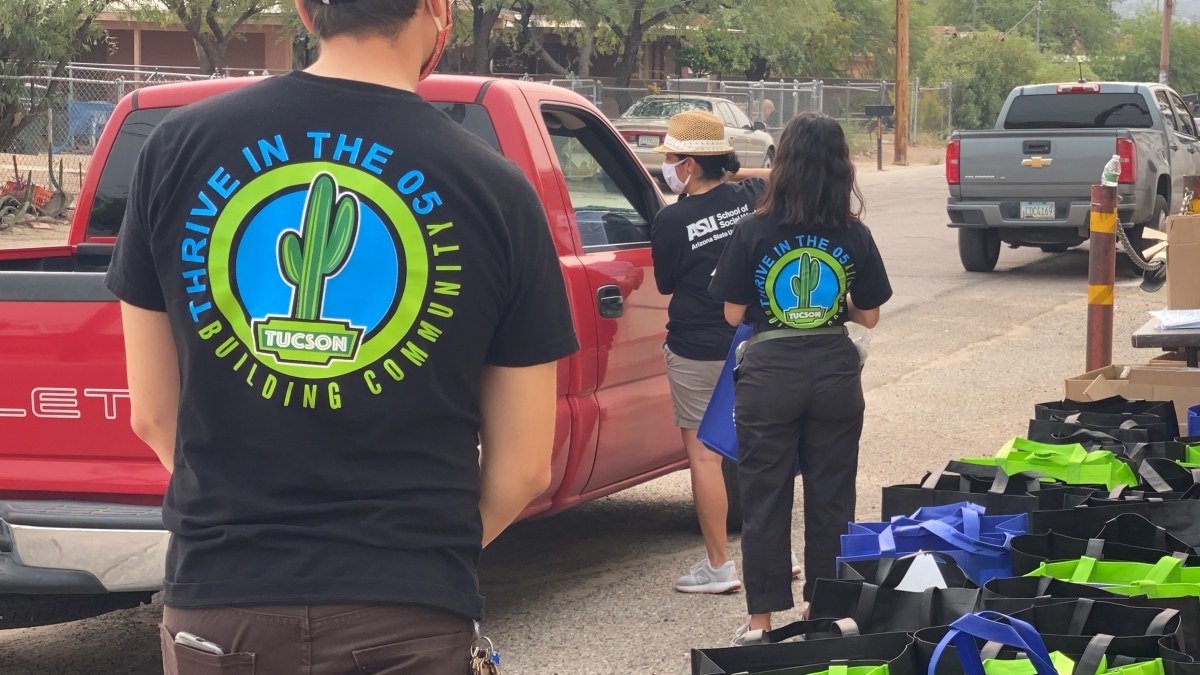Tucson revitalization effort earns School of Social Work President's Medal

Volunteers for the School of Social Work's Thrive in the 05 initiative hand out care bags to Tucson residents recently. Photo courtesy of School of Social Work
For the second straight year, a program of Arizona State University's School of Social Work will receive the President’s Medal for Social Embeddedness. ASU President Michael Crow will present the award this fall to the school’s Office of Community Health Engagement and Resiliency (OCHER) for helping revitalize an underserved Tucson community.
The initiative, called Thrive in the 05, is named for the 85705 ZIP code of a historically and culturally rich Tucson community that has suffered from decades of disinvestment, said Mary-Ellen Brown, director of the Tucson-based OCHER. The center’s staff has been implementing the initiative since its inception four years ago.
In 2020, Crow presented the medal to the School of Social Work-based Survivor Link, a team of ASU educators, students, faculty members and community volunteers who work to promote healthy relationships and provide domestic violence interventions in the community.
Brown said recognition from ASU and President Crow is a great honor. Brown, an assistant professor who in August will be promoted to associate professor, said she and her staff gratefully share the award with the entire Thrive in the 05 team, which includes many dedicated community-based partners, residents and volunteers.
“What started as the dream of a small group of ASU faculty and community partners has grown into a dynamic, place-based community initiative that has made great strides in reimagining community and building resiliency,” Brown said. “Our projects and interventions have created and strengthened pathways of opportunity for the people who live, grow, work, play and learn in the area.”
Thrive in the 05 initially was established in 2017 to help connect community members to holistically address safety concerns in the area but quickly expanded to seek out the root drivers of crime and improve social determinants of community health, Brown said.
Since then, the office’s staff and its community partnerships have expanded the initiative’s focus to include efforts to develop high-quality affordable housing, increased educational opportunities, more options to achieve greater economic mobility and to increase access to livable-wage career opportunities, she said.
“Through our partnerships, we’ve been able to reactivate neighborhood associations and engage in creative placemaking initiatives relating to improving and revitalizing neighborhoods and parks,” Brown said. “We also have several interventions under way that promote youth empowerment toward eliminating substance abuse and foster resiliency through training in wellness skills.”
Brown said Thrive in the 05 also includes a digital equity project designed to bring internet access to more 85705 residents as well as help older adults achieve digital literacy through technology training and support.
In May, the city of Tucson granted new funding to ASU OCHER for an innovative program called Tucson CARES, a partnership with social work, public health and medical students, Brown said. The students will be going door to door at the Tucson House, the city’s largest public housing community, and surrounding neighborhoods to promote health literacy and better connect underserved individuals with mental, behavioral and physical health supports.
“The great success that Mary-Ellen Brown and our other committed social work colleagues in Tucson have achieved is the result of their dedicated, outstanding effort to partner with a community to reenergize and prosper,” said Cynthia Lietz, Watts College of Public Service and Community Solutions interim dean and a President’s Professor of social work.
“The President’s Medal is a tremendous tribute to the initiative’s substantial forward movement in community service. This important recognition speaks to the value ASU assigns to translatable solutions. When developed and delivered in partnership with local communities, efforts like these contribute to the health and resilience in Tucson and across Arizona,” Lietz said.
The medal will be presented at the President’s Recognition Ceremony in the fall. Each year the event recognizes individuals either at the university or in the community for outstanding efforts to promote social embeddedness, innovation and sustainability. The occasion also honors top Serving University Needs (SUN) Award winners. SUN awards spotlight high achievement by individual university staff members.

